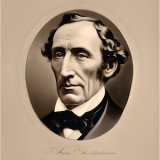The Goloshes of Fortune Page #5
"The Goloshes of Fortune" is a magical and whimsical tale by Hans Christian Andersen. It tells the story of a pair of magical boots that grant the wearer's deepest desires, taking them on unpredictable adventures. The book explores themes of desire, contentment, and the notion that the grass isn’t always greener on the other side. It's a delightful story reminding us to appreciate what we have, as our hasty wishes may lead to unexpected consequences.
previous evening. He had on the goloshes; they had not been sent for, and as the streets were still very dirty, they were of great service to him. A new poem, entitled "My Aunt's Spectacles," was being recited. It described these spectacles as possessing a wonderful power; if any one put them on in a large assembly the people appeared like cards, and the future events of ensuing years could be easily foretold by them. The idea struck him that he should very much like to have such a pair of spectacles; for, if used rightly, they would perhaps enable him to see into the hearts of people, which he thought would be more interesting than to know what was going to happen next year; for future events would be sure to show themselves, but the hearts of people never. "I can fancy what I should see in the whole row of ladies and gentlemen on the first seat, if I could only look into their hearts; that lady, I imagine, keeps a store for things of all descriptions; how my eyes would wander about in that collection; with many ladies I should no doubt find a large millinery establishment. There is another that is perhaps empty, and would be all the better for cleaning out. There may be some well stored with good articles. Ah, yes," he sighed, "I know one, in which everything is solid, but a servant is there already, and that is the only thing against it. I dare say from many I should hear the words, 'Please to walk in.' I only wish I could slip into the hearts like a little tiny thought." This was the word of command for the goloshes. The volunteer shrunk up together, and commenced a most unusual journey through the hearts of the spectators in the first row. The first heart he entered was that of a lady, but he thought he must have got into one of the rooms of an orthopedic institution where plaster casts of deformed limbs were hanging on the walls, with this difference, that the casts in the institution are formed when the patient enters, but here they were formed and preserved after the good people had left. These were casts of the bodily and mental deformities of the lady's female friends carefully preserved. Quickly he passed into another heart, which had the appearance of a spacious, holy church, with the white dove of innocence fluttering over the altar. Gladly would he have fallen on his knees in such a sacred place; but he was carried on to another heart, still, however, listening to the tones of the organ, and feeling himself that he had become another and a better man. The next heart was also a sanctuary, which he felt almost unworthy to enter; it represented a mean garret, in which lay a sick mother; but the warm sunshine streamed through the window, lovely roses bloomed in a little flowerbox on the roof, two blue birds sang of childlike joys, and the sick mother prayed for a blessing on her daughter. Next he crept on his hands and knees through an overfilled butcher's shop; there was meat, nothing but meat, wherever he stepped; this was the heart of a rich, respectable man, whose name is doubtless in the directory. Then he entered the heart of this man's wife; it was an old, tumble-down pigeon-house; the husband's portrait served as a weather-cock; it was connected with all the doors, which opened and shut just as the husband's decision turned. The next heart was a complete cabinet of mirrors, such as can be seen in the Castle of Rosenberg. But these mirrors magnified in an astonishing degree; in the middle of the floor sat, like the Grand Lama, the insignificant I of the owner, astonished at the contemplation of his own features. At his next visit he fancied he must have got into a narrow needlecase, full of sharp needles: "Oh," thought he, "this must be the heart of an old maid;" but such was not the fact; it belonged to a young officer, who wore several orders, and was said to be a man of intellect and heart. The poor volunteer came out of the last heart in the row quite bewildered. He could not collect his thoughts, and imagined his foolish fancies had carried him away. "Good gracious!" he sighed, "I must have a tendency to softening of the brain, and here it is so exceedingly hot that the blood is rushing to my head." And then suddenly recurred to him the strange event of the evening before, when his head had been fixed between the iron railings in front of the hospital. "That is the cause of it all!" he exclaimed, "I must do something in time. A Russian bath would be a very good thing to begin with. I wish I were lying on one of the highest shelves." Sure enough, there he lay on an upper shelf of a vapor bath, still in his evening costume, with his boots and goloshes on, and the hot drops from the ceiling falling on his face. "Ho!" he cried, jumping down and rushing towards the plunging bath. The attendant stopped him with a loud cry, when he saw a man with all his clothes on. The volunteer had, however, presence of mind enough to whisper, "It is for a wager;" but the first thing he did, when he reached his own room, was to put a large blister on his neck, and another on his back, that his crazy fit might be cured. The next morning his back was very sore, which was all he gained by the goloshes of Fortune. THE CLERK'S TRANSFORMATION The watchman, whom we of course have not forgotten, thought, after a while, of the goloshes which he had found and taken to the hospital; so he went and fetched them. But neither the lieutenant nor any one in the street could recognize them as their own, so he gave them up to the police. "They look exactly like my own goloshes," said one of the clerks, examining the unknown articles, as they stood by the side of his own. "It would require even more than the eye of a shoemaker to know one pair from the other." "Master clerk," said a servant who entered with some papers. The clerk turned and spoke to the man; but when he had done with him, he turned to look at the goloshes again, and now he was in greater doubt than ever as to whether the pair on the right or on the left belonged to him. "Those that are wet must be mine," thought he; but he thought wrong, it was just the reverse. The goloshes of Fortune were the wet pair; and, besides, why should not a clerk in a police office be wrong sometimes? So he drew them on, thrust his papers into his pocket, placed a few manuscripts under his arm, which he had to take with him, and to make abstracts from at home. Then, as it was Sunday morning and the weather very fine, he said to himself, "A walk to Fredericksburg will do me good:" so away he went. There could not be a quieter or more steady young man than this clerk. We will not grudge him this little walk, it was just the thing to do him good after sitting so much. He went on at first like a mere automaton, without thought or wish; therefore the goloshes had no opportunity to display their magic power. In the avenue he met with an acquaintance, one of our young poets, who told him that he intended to
Translation
Translate and read this book in other languages:
Select another language:
- - Select -
- 简体中文 (Chinese - Simplified)
- 繁體中文 (Chinese - Traditional)
- Español (Spanish)
- Esperanto (Esperanto)
- 日本語 (Japanese)
- Português (Portuguese)
- Deutsch (German)
- العربية (Arabic)
- Français (French)
- Русский (Russian)
- ಕನ್ನಡ (Kannada)
- 한국어 (Korean)
- עברית (Hebrew)
- Gaeilge (Irish)
- Українська (Ukrainian)
- اردو (Urdu)
- Magyar (Hungarian)
- मानक हिन्दी (Hindi)
- Indonesia (Indonesian)
- Italiano (Italian)
- தமிழ் (Tamil)
- Türkçe (Turkish)
- తెలుగు (Telugu)
- ภาษาไทย (Thai)
- Tiếng Việt (Vietnamese)
- Čeština (Czech)
- Polski (Polish)
- Bahasa Indonesia (Indonesian)
- Românește (Romanian)
- Nederlands (Dutch)
- Ελληνικά (Greek)
- Latinum (Latin)
- Svenska (Swedish)
- Dansk (Danish)
- Suomi (Finnish)
- فارسی (Persian)
- ייִדיש (Yiddish)
- հայերեն (Armenian)
- Norsk (Norwegian)
- English (English)
Citation
Use the citation below to add this book to your bibliography:
Style:MLAChicagoAPA
"The Goloshes of Fortune Books." Literature.com. STANDS4 LLC, 2025. Web. 22 Jan. 2025. <https://www.literature.com/book/the_goloshes_of_fortune_2172>.




Discuss this The Goloshes of Fortune book with the community:
Report Comment
We're doing our best to make sure our content is useful, accurate and safe.
If by any chance you spot an inappropriate comment while navigating through our website please use this form to let us know, and we'll take care of it shortly.
Attachment
You need to be logged in to favorite.
Log In